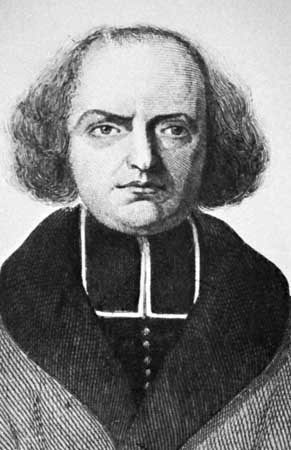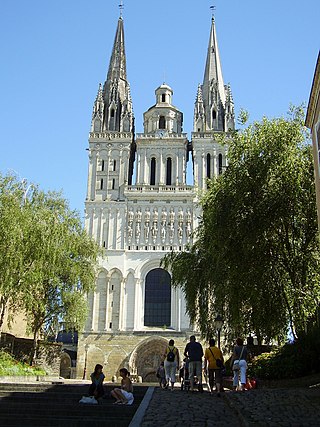Related Research Articles

Jacques Paul Migne was a French priest who published inexpensive and widely distributed editions of theological works, encyclopedias, and the texts of the Church Fathers, with the goal of providing a universal library for the Catholic priesthood.

Charles Forbes René de Montalembert was a French publicist, historian and Count of Montalembert, Deux-Sèvres, and a prominent representative of liberal Catholicism.

Louis Veuillot was a French journalist and author who helped to popularize ultramontanism.

Édouard Adolphe Drumont was a French antisemitic journalist, author and politician. He initiated the Antisemitic League of France in 1889, and was the founder and editor of the newspaper La Libre Parole. After spending years of research, he synthesised three major types of antisemitism. The first type was traditional Catholic attitudes toward the alien "Christ killers" augmented by vehement antipathy toward the French Revolution. The second type was hostility toward capitalism. The third type was so-called scientific racism, based on the argument that races have fixed characteristics, and asserting that Jews have negative characteristics.

Alain Manesson Mallet (1630–1706) was a French cartographer and engineer. He started his career as a soldier in the army of Louis XIV, became a Sergeant-Major in the artillery and an Inspector of Fortifications. He also served under the King of Portugal, before returning to France, and his appointment to the court of Louis XIV. His military engineering and mathematical background led to his position teaching mathematics at court.
John Dobree Dalgairns, English Roman Catholic priest, was born in Guernsey.

The Church of St. Louis of the French is a Catholic church near Piazza Navona in Rome. The church is dedicated to the patron saints of France: Virgin Mary, Dionysius the Areopagite and King Louis IX of France.
The Apostolic Vicariate of the Hawaiian Islands was the jurisdiction of the prelate of the Catholic Church in the Hawaiian Islands, created in 1847 by the Holy See. In 1848, the phrase Sandwich Islands was dropped and replaced by Hawaiian Islands. The first Vicar Apostolic of the Sandwich Islands was Msgr. Louis-Désiré Maigret, SS.CC. The Vicariate derives from the Prefecture Apostolic of the Sandwich Islands, established in 1825 and which was to become in 1833, a part of the larger territory under the ordinary jurisdiction of the Vicar Apostolic of Oriental Oceania entrusted to the Congregation of the Sacred Hearts of Jesus and Mary.

Prosper Louis Pascal Guéranger was a French priest and Benedictine monk, who served for nearly 40 years as the abbot of the monastery of Solesmes. Through the new Abbey of Solesmes he became the founder of the French Benedictine Congregation, which re-established Benedictine monastic life in France after it had been wiped out by the French Revolution. Guéranger was the author of The Liturgical Year, a popular commentary which covers every day of the Catholic Church's Liturgical cycles in 15 volumes. He was well regarded by Pope Pius IX, and was a proponent of the dogmas of the Immaculate Conception and of papal infallibility.
Neo-ultramontanism is the belief of certain Roman Catholics, primarily during the period immediately prior to the First Vatican Council, that papal infallibility was not restricted to a small number of papal statements but applied ipso facto to all papal teachings and statements.

Pierre Marie Joseph Veuillot was a Roman Catholic Cardinal and Archbishop of Paris.

The Roman Catholic Diocese of Tambacounda is a diocese located in the city of Tambacounda in the Ecclesiastical province of Dakar in Senegal.

The Diocese of Angers is a Latin Church diocese of the Catholic Church in France. The episcopal see is located in Angers Cathedral in the city of Angers. The diocese extends over the entire department of Maine-et-Loire.

Jean-François Anne Landriot was a French bishop, Ordained in 1839 from the seminary of Autun, he became, after a few years spent at the cathedral, successively superior of the seminary, 1842; vicar-general 1850; Bishop of La Rochelle, 1856, and Archbishop of Reims, 1867.

Jean-Joseph Gaume was a French Roman Catholic theologian and author.

Antonio Aparisi y Guijarro was a Spanish politician and journalist.
Le Correspondant was a French Catholic review, founded in March 1829 by Louis de Carné, Edmond de Cazalès and Augustin de Meaux, under the motto "Civil and religious liberty throughout the universe". It ceased publication in 1937.

Leo-Raymond de Neckère, C.M., was a Belgian-born prelate of the Roman Catholic Church who served as Bishop of New Orleans from 1830 until his death in 1833.
Monsignor James MacCaffrey STL, PhD was an Irish priest, theologian and historian.
The neocatólicos was a counter-revolutionary political tradition, faction or movement in late 19th-century Spain, emerged during the reign of Isabella II, akin to "Isabelline traditionalism" and "authoritarian conservatism", fusing anti-liberalism with the defence of the queen's dynastic legitimacy.
References
- ↑ Dr. John C. Rao. "Louis Veuillot: Icon and Iconoclast". Archived from the original on 2010-03-04. Retrieved 2007-02-20.
- ↑ Great Catholic Writers